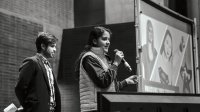Project-Based Learning in Colombia
An American educator reports on how the South American nation is using PBL.
Your content has been saved!
Go to My Saved Content.Project-based learning is enjoying a global groundswell of interest as schools around the world adopt strategies to prepare their students for future success. In Colombia, the need for a new kind of education is especially acute. This South American country, recovering from a half-century of civil war, is betting its future on students who know how to solve problems peacefully and creatively.
I had a chance to learn about the challenges and opportunities facing students and educators in Colombia as a presenter at the recent Revolution in Education Congress. Held on the modern and welcoming campus of Gimnasio Los Caobos, a progressive school on the outskirts of Bogotá, the event attracted nearly 200 educators from schools across the country.
“Getting students engaged with learning is a top priority to combat rising issues with drug abuse, school dropouts, and many other issues,” said Gabriel Enrique Diago Méndez, director of technology and innovation at Gimnasio Los Caobos and a conference organizer. “Colombians are known for being creative. If we teach them how to use that creativity in a positive way that can help society, and connect their ideas to people who can make them a reality, that will create a better, stronger Colombia and a better future for everyone.”
PBL in Action
Examples are already bubbling up at Gimnasio Los Caobos as students apply their problem-solving to real-world challenges. One student team, for example, has developed an app called Mission Team that teaches children with Down syndrome how to follow traffic laws on Colombia’s congested streets. To develop their idea, students connected with medical specialists from Spain and technology experts from the United States. They also tapped into their own empathy to understand user needs. The inspiration for the project was a student’s sister.
Another project aims at expanding Colombia’s chocolate industry through improved use of technology for growing and processing. If successful, the project could help expand the country’s economy.
Two other examples: a middle-school project that culminated in a half-hour variety show explored how comedians use spoken words, body language, and cultural references to draw laughs; and young entrepreneurs developed ideas for business start-ups to pitch to experts.
Diago graduated from Gimnasio Los Caobos just a decade ago. His search for educational innovation took him to an event at Harvard a few years ago, where he met Frank Locker, a school design expert. They have been collaborating ever since, rethinking everything from pedagogy to learning spaces that encourage more student-driven learning and teacher collaboration.
Develop Driving Questions
During my workshops at the conference, I listened to teachers brainstorm project ideas about everything from reducing road congestion to turning schoolyards into wildlife habitats to celebrating the literary legacy of Nobel laureate Gabriel García Márquez. We focused specifically on strategies to amplify authenticity so that students will know they’re applying learning to real-world challenges.
I suggested that teachers consider these three questions to make project ideas more authentic:
- Does the project focus on a real problem or challenge that students can engage with locally? Is it a “right-sized” problem? For example, students often spend an hour or more commuting to schools across Bogotá. Tackling this as a problem would get students to gather data, analyze energy use, and apply systems thinking. Leaving the solutions open-ended might lead them to improve carpooling, advocate for Wi-Fi-enabled buses, or request more online learning opportunities.
- Does the project require authentic processes for problem solving? Will students be asking questions, investigating solutions, and applying standards of excellence in the same way that experts do?
- Will the product have real impact? How will students know that their solutions or proposals have made a difference? How have they changed attitudes or behaviors?
Teachers also need to encourage strong student voice in PBL so that projects will focus on “unique problems that students want to solve,” Diago added. One teacher participant, acknowledging the appeal of real-world learning for students, pointed out another challenge: how to get parents comfortable with learning that extends “beyond the safe bubble of the classroom.”
Being of Service Increases Student Engagement
In his opening keynote address, Steven Levy, a longtime PBL advocate from EL Education, underscored the urgency of efforts to transform education in Colombia. Student motivation increases, Levy said, when students see projects not as requirements to be fulfilled but rather as opportunities “to be of service.” (EL Education, formerly known as Expeditionary Learning Schools, is a network of schools that emphasize project-based learning and community engagement.)
As evidence, Levy hauled along two suitcases filled with examples of student projects that have created such opportunities. Teachers pored over the samples, including biographies that students wrote to honor elder citizens in their communities and instructional materials that students developed to teach language skills to village children lacking resources.
By the end of the conference, teachers were buzzing with ideas they were eager to try and problems they were willing to tackle with their students. The shift to PBL will not be an overnight transformation, cautioned David Ross, CEO of the Partnership for 21st Century Learning and another presenter at the event. “Plan on three to five years,” he said.
Nonetheless, one government official who spoke at the closing ceremonies encouraged teachers to be “restless” in their pursuit of better education. “Our students need training to take civic responsibility. We need tools to make young people fall in love with education,” he added. “That’s the engine that will move our society forward.”
